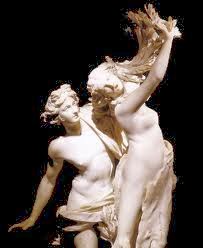As Carol and Roger walked through the Piazza Navona in Rome, they passed by the Four Rivers Fountain by the sculptor Gian Lorenzo Bernini. We were both impressed by how life-like the figures in the fountain were. Little did we know at that point how Bernini could bring marble to life.
 |
| Self-portrait. Courtesy: Galleria Borghese |
Gian Lorenzo Bernini was born in 1598, the son of a notable if not masterful sculptor. He came a century after Michelangelo. The two are often compared…as we will do a bit later.
Bernini was a prodigy, who began sculpting museum-quality work before he reached his teens. He had a violent temper and was jailed for a while after killing a man in a dispute over a sporting event.
 |
| Courtesy: Galleria Borghese |
As a teen-ager, Bernini was “discovered” and taken under the wing of Cardinal Scipione Borghese, the nephew of the second Borgia pope. One of Bernini's first commissions was this bust of the Cardinal
 |
| Courtesy: Galleria Borghese |
Scipione Borghese is best known for his breath-taking art collection, housed in Rome’s Galleria Borghese. The Cardinal, like his more famous ancestors, was a ruthless man, willing to go to any extreme to obtain the art he desired. He stole one painting from the Cathedral in Bologna. He threatened another painter with life imprisonment if he didn’t sell him a painting already commissioned by another patron.
 |
| Courtesy: Galleria Borghese |
All of the art he collected or extorted came here…a prime example of baroque over-statement. The rooms that house the sculpture and paintings are themselves works of art.
It was here, in the Galleria Borghese, that Carol and Roger really came to appreciate what Bernini could do with a block of marble.
 |
| Courtesy: Academy Museum |
You are all familiar with Michelangelo’s statue of David…powerful and stoic.
Here’s Bernini’s version of the same Biblical hero.
The spirit of David seems ready to burst out of the stone.
[Just a note: this photo doesn't begin to do the sculpture justice.]
 |
| Courtesy Galleria Borghese |
Note the look of determination on David’s face. He appears to be saying, “This is my one, my only, shot to nail Golaith. If I don’t get it right, I’m dead.”
This statue of David is one of four masterpieces Bernini did for Scipione Borghese in six years…all in his early twenties. Here are the other three…all with classical themes.
 |
| Courtesy Galleria Borghese |
Aeneas, Anchises, and Ascanius: After the Greeks capture Troy and sack the city, the Trojan hero Aeneas carries his elderly father and infant son to safety.
 |
| Courtesy Galleria Borghese |
The Rape of Proserpena: The god Pluto sees the mortal beauty Proserpena and is instantly smitten with here. He grabs her to take to his kingdom in the underworld, from which she can never return. Notice not only the power in Pluto’s body, but the life-like look of despair on Proserpena’s face.
 |
| Courtesy: Galleria Borghese |
Apollo and Daphne: A story from Ovid’s Metamorphoses…Apollo is struck by Cupid’s arrow as he spies Daphne…who by contrast has been fated by the gods to deny the love of men. Daphne tries to flee. If she can reach a tree before Apollo gets to her, she will turn into that tree and be safe.
 |
| Courtesy Galleria Borghese |
The sculpture depicts that instant when Apollo grasps Daphne just as she has reached the tree.
 |
| Courtesy Galleria Borghese |
Daphne’s toes are turning into tree roots, and her fingers into leaves. Her face is a picture of frantic desperation.
Magnificent!
Carol actually cried when she saw this sculpture; it was so beautiful.
Bernini went on to design and sculpt several altars in St. Peter’s Basilica at the Vatican. He was also the architect who designed the colonnade at St. Peter’s Square.
 |
| Courtesy: Vatican |
Bernini went on to design and sculpt several altars in St. Peter’s Basilica at the Vatican. He was also the architect who designed the colonnade at St. Peter’s Square.
Ultimately, Bernini became known for “creating the Baroque style of sculpture.” Carol and Roger love his work because he’s able to express emotions in marble more effectively than any other.
 |
| Courtesy San Francisco in Ripa, Rome |
His tomb for Ludicovica Antonioni is a case in point. Look at her face in the moment of death.
A few days after visiting the Galleria Borghese, Carol and Roger were walking down the Appian Way. They passed the Church of San Sebastiano, which is famous for its catacombs.
The catacombs were closed, so we went inside the church…only to find another Bernini tomb that is apparently so “average” it flies below all the art historians’ radar.
There are thousands—-perhaps tens of thousands—-of images of Jesus in Rome. He is portrayed in many ways but almost never as a real human being. As we were leaving San Sebastiano, we saw something remarkable.




Oh, one of my most favorite places in the world along with the Pantheon. Happy Holiday. Fay
ReplyDeleteI remember being very impressed and moved by Bernini's marble sculptures at the Borghese. Thanks for the memories!
ReplyDelete